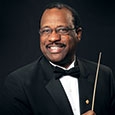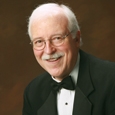Alfred L. Watkins has enjoyed a conducting and teaching career that spans four decades and touched the lives of over 10,000 students. He spent the first six years of his career as Director of Bands at Murphy High School in the Atlanta Public School System. In 1982 he became Director of Bands at Lassiter High School in Marietta, Georgia where he taught until his retirement in 2013. Under his leadership, the Lassiter band grew from 78 students to more than 400. His bands have performed four times at the Midwest Clinic as well as at the National Band Association Convention, National Concert Band Festival, and GMEA. The Trojan Marching Band performed four times in the Tournament of Roses and three times in the Macy’s Thanksgiving Day Parades.
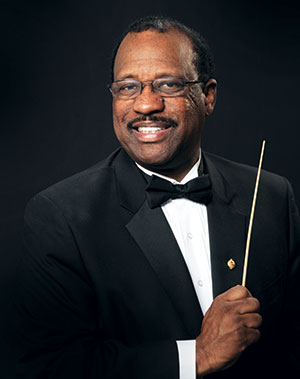
What strategies do you use in the important first minutes of a rehearsal?
All rehearsals at Lassiter operated essentially the same way. I wanted classes to start with quiet and calm. With a 250-piece marching band, the students sat for a brief band meeting, and I described the last rehearsal and our short-term goals moving forward. In concert band, I wrote the music for the day and described our goals. The rehearsal room was clear of extra chairs or stands. A tidy and well-organized classroom allows students to enter quietly and move directly to get their materials. When a room was in disarray, students saw that rehearsal as less important. If students were absent, extra chairs were quickly removed.
I eliminated anything chaotic in the room. For example, drummers were not allowed to play on their instruments unless conducted. They could play on pads or on keyboard instruments using soft mallets. The intent was to get their arms loosened up. A loud percussion sound can create a chaotic atmosphere and start the period with a lack of order. Once students were trained to do that, there were no problems.
Once wind players had their instruments assembled, they chose from 15 to 20 ordered warmups, typically with moderate volumes and tessitura. These included long tones and scalar passages that were not too offensive to the embouchure. In the beginning of the year, we worked through each one. This routine produced a relaxed and focused rehearsal.
What ensemble warmups and strategies did you use?
I left nothing to chance and made sure that the class was positive, enthusiastic, and as free of stress as possible. The music sometimes creates stressful moments, and the ensemble did not need me to add to it. For most of my career I had four or five concert bands. I did not ask the advanced band to play the same exercises as the fifth band, but the approach to music making was the same.
I called this part of rehearsal warming up for many years, until some brainiac students noted that it does not take that long to warm up a flute. We changed the expression to developmental exercises. I compared our work to a golfer taking practice swings or basketball players practicing layups. I asked them to think about the meaning behind what they were doing. As Gen. Colin Powell writes, “It worked for me!”
.jpg)
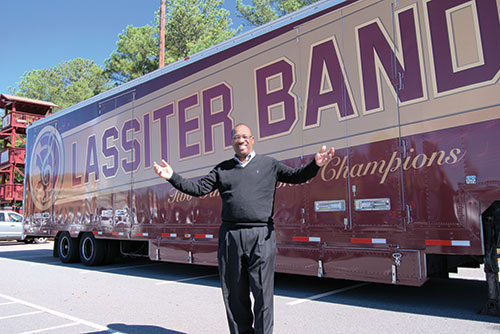
What did a successful rehearsal look like for you?
I taught 55-minute classes for most of my career with regular after school rehearsals for marching, jazz, concert band, or chamber ensembles. I used 40%-50% of each class period to emphasize fundamentals. The literature was just a matter of transferring learning. Almost all classes began with breathing exercises to wake up the lungs. Students generally use a small amount of lung capacity when asleep or sitting in chairs in other academic classes. When students come to band, the lungs are half asleep. We did a series of inhalations and exhalations to expand and condense the lungs to allow air to move freely through the body without tension.
Humming. When we tried singing earlier in the school year, the bashful ones were too reserved to sing out loud. Humming on a fixed pitch works just as well for waking up the ears. We sang various intervals without a metronome.
Long Tones. We continued with long tones using the Emory Remington studies. We centered them on concert F, going down the seven chromatic positions and back up in half notes at a tempo of 86. In all of our exercises, I maintained a controlled environment with a tempo ranging from 86 to 100. After the exercise on F, we played one on low Bb to create a nice rich low-register sound. Then we switched to the octave above while attempting to maintain the same rich and resonant sound. These exercises were at mezzo forte and were in slurred half notes or whole notes – never too quick or tongued.
Slurring. We slurred exercises to make it easier to produce a smoother airflow rather than using the tongue to change sounds. It is my opinion that we use the tongue too much in our teaching. It is not a valve for precision – understanding is. Toe- tapping was encouraged, but toes only. Not the entire foot. We think of the tongue as a weak muscle, but it is actually one of the strongest. I avoided using the word attack in favor of initiate to describe starting the sound. I talked about initiation, duration, and closure (instead of release or stop). I use non-violent terms even on half notes. We typically played an assortment of scales for one octave to allow them to focus on the beauty of the sound and pitch at the same time.
Scales. On alternating days, instead of the Remington, I did unison major scales, going through the circle of fourths. Then we played the F concert scale in two octaves, using whole notes earlier in the year and half notes most of the year. Longer note values tend to allow students to hear the smoothness of the sound from the beginning, middle, through to the end of a tone.
Tendency Tones. We taught students the five worst notes on their instruments (tendency tones) realizing that most instruments have more than five. We played with a “center of pitch” concept with adjustments to the tendency tones. I figured if students could remember the worst five notes on an instrument, they would be way ahead of the curve. As we played scales, I asked students to focus on their tendency tones.
Add-a-Tone Drill. Students slurred a Bb concert scale in quarter notes at m.m. = 86. They played up the major scale and held the eighth scale degree for a two counts to hear the pitch and timbre of the sound, and then come back down the scale holding the last tonic note for three counts. Next, the scale was played up to the ninth degree and holding it for a few counts before going back down. We did this exercise up to the twelfth degree with a goal of keeping the timbre of the sound the same even as notes were added. We called those consistent sounds purple. If the tone thinned out or became pinched, we called those tones pink. We tried to avoid pink sounds.
Rhythm Builders. I loved using 40 Rhythmical Studies by Grover Yaus because it was the best book to teach interpretation of rhythms. Julian E. White, Assistant Director at my alma mater was a retired and successful high school band director in Florida. He taught our band methods courses and insisted that we learn the values of classroom methods. We lived in the music library. Most of the exercises were six-line exercises in simple keys that allowed for students to focus on rhythms first and notes heads second. When most youngsters read music, they read the note heads first because that is where the song is located. As a result, they tend to struggle with the rhythms for many years to come. With rhythm exercises, we focus on the noteheads second and the stems and flags first. After the first day, the mature students are working on musical style or dynamics. With my advanced bands, if the key was a simple one such as Eb major, they read straight through it, and I asked them transpose it up to E major, forcing them to think through the sharps and the flats.
Technique Builders. Each band used a separate technique builder that was designed not for speed but for teaching finger patterns. We typically played scales in thirds, fourths, and fifths in several keys; the intervals were consistent throughout the exercise. These exercises took the brass from the bottom of the range to the top, while woodwind players often worked on alternate fingerings and their upper register. I didn’t use these techniques as fast as one would think. My signature book for my advanced classes for 30+ years was Unisonal Scales and Chords by William White. This was another Julian E. White suggestion. It worked. Younger bands used less difficult books but focused on the same principles.
Tuning. Tuning was an active practice at Lassiter as long as sounds were being made and not simply a one-time event during rehearsals. We focused on humming, singing, and matching sounds all the time. Students were taught to play with a good characteristic sound first and adjust it second. High-quality sound came before blend. Listening generally involved two processes: Tuning horizontally to match sounds in or near your octave, and tuning vertically to listen to sounds above and below you – but mostly below. With chords, we used adjusted intonation. Finally, we went through the process of getting instrument lengths set for the rehearsal, what we call tuning. This was often a left-brain activity dealing with mostly the science of music, although listening (right brain) was also strongly used to match pitch. Because we played so much in unison we are pretty close in the matching process.We typically tuned (in unisons and not octaves) and to a fixed pitch. After tuning we played harmony, typically chorales or anything that was homophonic. I liked working with chorales in Claude T. Smith’s Symphonic Warm-Ups for Band, Bach chorales, and James Curnow’s Tone Studies for Band, Parts 1 or 2.
What is your approach to repertoire selection?
It is important to give students a musical vocabulary. The Japanese music pedagogue Shinichi Suzuki suggested that we learn spoken language by hearing it first. I agree, so I gave students a broad musical vocabulary. We spend a dozen years in English classes on words, how they work together, and how to construct sentences. We are less thorough in music. In many cases, we play three or four tunes a semester, and just play the technique without any understanding of the vocabulary.
In college, I would attend a recital or hear a piece in a practice room played by another trumpeter, and I would find that music, take it to the practice room, and do what I call a scavenger hunt. I’d play it through to see how it felt and how it was put together. I transferred that approach to teaching an entire band. We played nearly 100 pieces a year with the advanced band and almost 75 with the second band. The third band would play about 60, fourth band about 40, and the fifth band about 20 pieces. That may or may not include the pieces for a concert. The concerts were less important to me than the process of developing a vocabulary. If you’re rehearsing something and a baroque dance comes up and students have never heard one, they will struggle. The same is true with a fugue. In the first semester, During the first semester, I usually selected music one grade level less advanced than the performers. I wanted to teach the importance of melody, line, counterpoint, form, structure, harmony, beauty, stretto, fragmentation, and other compositional tools instead of just having them struggle through the Hindemith Symphony. That comes later.
During second semester we focused more on concert literature but played something new every day. Reading so much music with our groups allowed us to teach musical style and all the nuances that students might miss if they were struggling with parts.
How do you use a metronome in rehearsals?
I use those sparingly in concert band. I want my baton to show where the pulse is. I use the metronome much more often with a marching band, which helped keep rehearsals organized. With a band of 280, it can take a while for freshmen to figure out the pulse. Some directors use the metronome the same way with concert band rehearsals. The greatest issue I have with playing the metronome as loudly as the band is playing is that the teacher and students can only hear rhythm. This simply keeps the band on pulse and generally does not develop strong rhythmic skills and only helps with the music at hand making it difficult to transfer learning to hear critical element. The metronome is a tool most used by individuals to correct minute rhythmic issues as they arise, not a band trainer. You cannot hear the beginning and end of notes, and neither can students. They can’t hear internal harmony and balances. More importantly, they play at the volume of the metronome. I played my metronome underneath the sound of the band, if needed. The metronome is the most poorly used tool in our arsenal.
How do you approach the first experience with a new piece?
Musical rehearsals must be fun. When I was a young director, John Paynter told me that students come to us with different perceptions of fun. He said some students enjoy reading War and Peace, and some enjoy a walk in the park. He said it was our job as conductors to help students perceive fun the way we perceive it.
The music must be interesting to the conductor and students, almost like the discovery of a new jewel. If it was something we were going to play at an event, a large-scale work like Symphonic Metamorphosis or the Persichetti Symphony, I let them hear the piece first. The reason for that, especially with younger groups, is that students will tell their classmates at the end of first rehearsal whether the liked the piece or not. If the low brass had a boring part, they would say, “I don’t like that piece.” If they were to hear a seven- or eight-minute recording before playing, they hear parts where their section is featured that will come up in later rehearsals and love the work. Sold!
Before we read through a work, I would always include a short bio of the composer’s biography, establish a musical setting, country of origin, style, and musical period it comes from. It is critical that we develop personal relationships with composers to better understand the compositional process. If it were a programmatic piece, I’d tell them the story. I’d address some parts of the form, but more importantly, I’d describe the mood and the musical personality. If students have the skills, we play the music all the way through. I’d put ritards, accelerandos, changes of articulation, and volume shifts on the baton from the beginning. I would never play it with the metronome. The students needed to hear the song.
Programmatic works are always easier to teach. I taught absolute compositions through the musical ideas, explaining about such elements as melody and motifs. With much of my teaching, I tried to do what Leonard Bernstein did with his Young People’s Concerts. He taught broad concepts in the simplest, most understandable manner. He made absolute music easy to understand.
I am troubled by some conductors who manage to make complex music more complex when rehearsing with an honor band. These conductors are trying to show that they are good musicians, but students do not really care about that. They care whether you care about them, whether you want the music to be enjoyable, and whether the rehearsal that day will be our version of fun. It is important to talk to students as collaborators and as developing musicians, not as pawns to play the technique of a piece for us. It is difficult sometimes for a 60-year-old to collaborate with a 14-year-old, but that is our job.
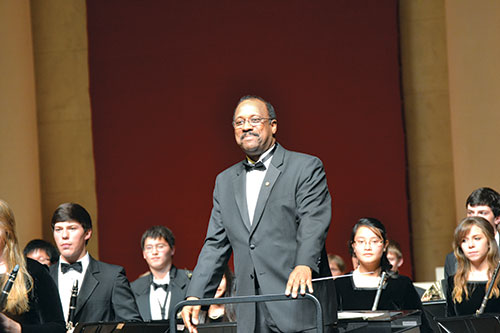
What are some common mistakes you see in younger directors?
Teaching comprehensive musicianship is the key; not just teaching a song. Developing musical excellence is certainly the most essential component of the job but it is the approach that can problematic. I think we place too much emphasis on competition. That might sound strange to some since I led what appeared to be a highly competitive marching band. We never competed more than four times a fall. It is critical that students, directors, and families have time away from the music program. It draws too much attention to championships and the things that belong to the teacher. Some think that competition serves the students, but I don’t think that it does. Handled inappropriately, it serves our own egos.
Our marching band only rehearsed eight hours a week, and that started 25 or 30 years ago, before eight-hour rules came to some parts of the country. Generally, we rehearsed only one Saturday in August and one in September even on years when we competed at Grand Nationals. I asked the community to let October be our month for competitions. We did three competitions in October, and I used one Saturday to polish things up. There were essentially six or seven Saturdays from the beginning of school that students were involved in marching band after band camp.
My staff and I never discussed winning with our students. Never. We never discussed losing either. I just discussed the highest level of achievement that you can get. This focus on individual excellence would transfer to all other types of playing of ensembles ranging from jazz band to the first clarinet part in the third concert band.
I did not allow for challenges in the band. I did in the first several years of my career, and realized that it caused conflict in sections as students began to get rubbed the wrong way. If I corrected intonation in a section, the student who won a challenge assumed that the other student was responsible for the pitch problem. It also led to frayed emotions, which actually hurt the ensemble in many ways. We did re-audition for chairs around four times in a year.
Some less experienced directors show a lack of understanding of pedagogy. I think it is critical that all teachers learn all the instruments, all the fingerings, and more importantly, how the embouchures are formed for every instrument and the characteristic sound in every register. This includes preferred equipment, reeds and mouthpieces.
Our best resources for that are the brass, woodwind, percussion and string method books that we used in methods classes in college. There are other excellent ones on the market. Our professors remain a resource even after graduation. Most college students think of graduation as the end of a study period. Commencement means the beginning of a specific study rather than the end of the process. College courses are research classes on myriad subjects, but the true study occurs when you have completed formal education. Continued learning will keep you fresh, vibrant, and creative.
Young directors also think they can talk their way to a good band. If you talk to students as your college professors spoke to you to create the music, there is a good chance that you will fail. A college professor works with students who are studying in applied studios. Our college classes are mostly done in lecture style. Over half of our students are visual learners.
Many young teachers also have problems with classroom management. We often do not know what it means to manage a class. I encourage young directors to go out and watch successful teachers in the area who manage their classes in polite, kind, and thoughtful ways so that management of the class aids the music making.
We are taught to find mentor teachers in the area and imitate methods in their teaching. Sometimes this works, sometimes it doesn’t. That is good in some aspects like classroom management and efficiency in rehearsals. From the standpoint of pedagogy and literature, I say no. I’m 63 years old. If a student mimics me, my practices are based on who I was mentored by 40 years ago. I tell teachers to find the best in the industry and siphon information off of them, and ask them to be a mentor. Most of all just be inquisitive, and they will share.
My mentors included four or five middle school band directors in the Atlanta public school system who were good husbands, fathers, and bandmasters. They taught in deprived communities but with a high level of musicianship, and their ensembles were very good. I learned that poor kids can learn with good instruction. These mentors taught me to be a future husband and father. My college directors, William P. Foster, Director of Bands at FAMU, Julian E. White, Classroom Methods Instructor at FAMU, and my classical trumpet professor, Lenard Bowie, were extremely excellent mentors for me. All were well-trained African-American classical musicians who developed a community of musical excellence for us. The small college program was based as much on character development as it was good musicianship. I owe them everything.
I also sought out Harry Begian, William Revelli, John Paynter, Fred Fennell, and Arnald Gabriel. They were my five mentors outside of Georgia. I called them every month or two and became very good friends with all of them. They heard my groups over the years and offered advice on how to build a program and select literature. All of these directors conducted in my rehearsal room at Lassiter at some point. None of these men ever gave me any formal education, but they were the best in the world at what I was doing, and they shared information with me forever. Harry Begian would come to Lassiter and always stayed at the house with my family. This allowed us to talk shop late night.
It is critical to invite outside veteran conductors into your rehearsal room early in the process. When the music is almost ready for performance, it is too late. This could involve sending a rehearsal tape to a mentor and asking for notes.
.jpg)
What approaches did you use to keep students from quitting your ensembles?
It is important that the director believes every student is important. With a cooperative spirit, every student can learn and contribute to the program. In many cases we teach to the top of the class and assume that students near the bottom are not interested. All students who can match pitch can learn music, albeit at different rates of learning. They may have varying reasons for struggling initially. Sometimes we use students as pawns in our personal successes. If teachers can figure that out, so can students. It was my job to create joy, enthusiasm, and excitement, and esprit de corps to the 10,000 students I taught in my career.
* * *
Alfred L. Watkins is an alumnus of Florida A&M University. In his three decades at Lassiter High School, the Trojan Band was named Sweepstakes Winners in 106 of 112 competitions entered, including twice being named the Bands of America Grand National Champions. Watkins is also Cofounder, Musical Director, and Conductor of the Cobb Wind Symphony, an award-winning adult community band based in Marietta. He is also Cofounder and President of the Minority Band Directors National Association. Among his many honors, Watkins is a member of the American Bandmasters Association, the FAMU Gallery of Distinguished Alumni, the Bands of America Hall of Fame, and the Phi Beta Mu Georgia Bandmasters Hall of Fame. The $1.5 million Alfred L. Watkins Band Building at Lassiter bears his name.
